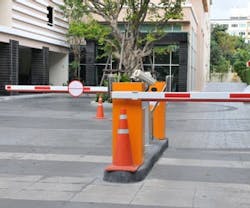Hardening your existing building against bomb threats may seem like a tall order, but you never know when a high-risk tenant will change your security risks.
“You can’t really harden a building by renovating, but you can modify the site,” says Sean Ahrens, global practice leader and manager of Security Consulting and Design Services with Aon Fire Protection.
Install bollards and barriers, extend stand-off distances, and increase your security officers to cause potential bombers to look for another target.
Stand-off Distances
Modifying a site begins with making the most of the existing stand-off distance.
“Stand-off distance is key,” says David Dickinson, senior vice president with vehicle barrier manufacturer Delta Scientific. “Stand-off distances provide a clear space where no vehicles are permitted. Every inch counts. You push out away from the building as far as you can and put a barrier there. If a vehicle bomber tries to get to the building, that is where the crater will be.”
Related considerations include locations of cabstands, drop-off zones, and parking meters. “Push these areas away from the building,” suggests Ahrens. This way, when a cab or other vehicle comes too close to the building, it will stand out and security officers will move it along.
Bollards and Barricades
Barriers such as bollards and barricades can also keep vehicles away from a building. Effective barriers have crash ratings keyed to the size of vehicles and the speed at impact. “For high-risk locations, we recommend barriers that will stop a 15,000-pound vehicle traveling at 50 miles per hour,” says Dickinson.
Downtown buildings typically don’t need barriers or bollards that strong because traffic on urban streets slows vehicles substantially, says Dickinson. A lower rated barrier will stop a 15,000-pound truck traveling 20 miles per hour.
Since 1995, Mike Fickes has contributed over 200 security articles to publications covering hotel, industrial, office, retail, critical infrastructure, and education. His interests include security management, policies, strategies, and technologies.
“Be careful about what is beside a barrier,” adds Dickinson. “You don’t want someone to drive around it or drive through the wall. It’s important to balance the strength of the barrier with the rest of the perimeter. You can do that with decorative planters, berms, or cable-backed fencing.”
Barricades can also protect garages. A staffed security booth and a barricade can add a layer of protection at the entrance. As officers inspect and pass vehicles, they lower the barricade.
Barriers need not ruin the look of a building. Aesthetic bollards allow people to pass through but block vehicles. When a high-risk tenant moves on, you can lower the barricades and store them in place until another tenant arrives.
Hostile Surveillance
While barriers and set back distances will protect your building from a bombing, an attack can still cause injuries and damage. Better to prevent an attack altogether.
“If I were a building owner, I would focus on the operational component of an attack,” says Ahrens. “When choosing a target, attackers investigate buildings and look for those with weaknesses. They might sketch buildings and shoot photos or video. If you see people studying your building, challenge them. Sometimes that’s all it takes to stop an attack.”
You can also report surveillance to federal authorities. In 2006, the security cameras at Willis Tower in Chicago picked up video of three men getting out of a car near the loading dock. One of them photographed the building while the others scanned the surroundings as if standing watch. Security officers challenged them and made them leave.
Building security gave the surveillance video and the car’s license number to federal authorities. The men had rented the car using a fake name. If there was a budding plot, it came to nothing, quite likely because security discovered the reconnaissance effort and acted.
While physical security can protect your building from an attacking vehicle, it’s better to prevent a crisis by spotting a recon team, challenging them, and reporting them to the authorities. With luck, you won’t have to find out if the bollards and barricades really will stop a vehicle
